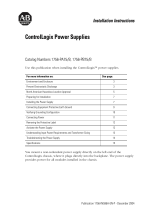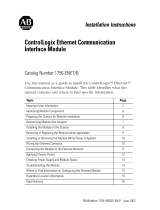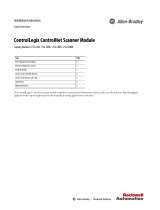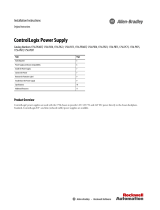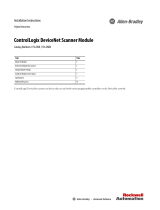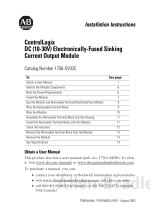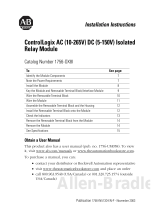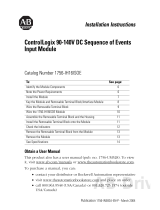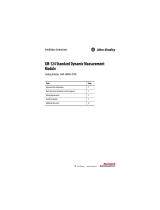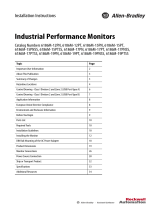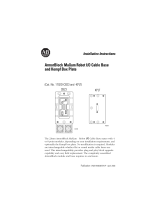La page est en cours de chargement...

Installation Instructions
ControlLogix EtherNet/IP Module
Catalog Number 1756-EN2T
About This Publication
Use this publication as a guide to install the module. This publication describes
hardware installation only. For configuration information, refer to the
EtherNet/IP Modules in Logix5000 Control Systems User Manual, publication
ENET-UM001
. View or download this publication at
http://www.rockwellautomation.com/literature.
Topic Page
About This Publication 1
Before You Begin 7
Determine Module Slot Location 8
Set the Network Address 9
Install the Module 11
Connect the Module to the EtherNet/IP Network 12
Program the Module via the USB Port 14
Configure the Module 15
Apply Chassis Power 15
Check Power Supply and Module Status 16
Install or Remove the Module Under Power 17
Interpret the Status Indicators 19
Specifications 22

2 ControlLogix EtherNet/IP Module
Rockwell Automation Publication 1756-IN603C-EN-P - April 2010
Important User Information
Solid-state equipment has operational characteristics differing from those of electromechanical
equipment. Safety Guidelines for the Application, Installation and Maintenance of Solid State Controls
(Publication SGI-1.1
available from your local Rockwell Automation sales office or online at
http://www.rockwellautomation.com/literature/
) describes some important differences between
solid-state equipment and hard-wired electromechanical devices. Because of this difference, and also
because of the wide variety of uses for solid-state equipment, all persons responsible for applying this
equipment must satisfy themselves that each intended application of this equipment is acceptable.
In no event will Rockwell Automation, Inc. be responsible or liable for indirect or consequential damages
resulting from the use or application of this equipment.
The examples and diagrams in this manual are included solely for illustrative purposes. Because of the
many variables and requirements associated with any particular installation, Rockwell Automation, Inc.
cannot assume responsibility or liability for actual use based on the examples and diagrams.
No patent liability is assumed by Rockwell Automation, Inc. with respect to use of information, circuits,
equipment, or software described in this manual.
Reproduction of the contents of this manual, in whole or in part, without written permission of Rockwell
Automation, Inc., is prohibited.
Throughout this manual, when necessary, we use notes to make you aware of safety considerations.
WARNING: Identifies information about practices or circumstances that can cause an
explosion in a hazardous environment, which may lead to personal injury or death,
property damage, or economic loss.
ATTENTION: Identifies information about practices or circumstances that can lead to
personal injury or death, property damage, or economic loss. Attentions help you
identify a hazard, avoid a hazard and recognize the consequences.
SHOCK HAZARD: Labels may be on or inside the equipment, for example, drive or
motor, to alert people that dangerous voltage may be present.
BURN HAZARD: Labels may be on or inside the equipment, for example, drive or
motor, to alert people that surfaces may reach dangerous temperatures.
IMPORTAN
T
Identifies information that is critical for successful application and understanding
of the product.

ControlLogix EtherNet/IP Module 3
Rockwell Automation Publication 1756-IN603C-EN-P - April 2010
North American Hazardous Location Approval
The following information applies
when operating this equipment in
hazardous locations.
Informations sur l’utilisation de cet
équipement en environnements
dangereux.
Products marked “CL I, DIV 2, GP A, B, C, D” are
suitable for use in Class I Division 2 Groups A, B, C,
D, Hazardous Locations and nonhazardous
locations only. Each product is supplied with
markings on the rating nameplate indicating the
hazardous location temperature code. When
combining products within a system, the most
adverse temperature code (lowest “T” number)
may be used to help determine the overall
temperature code of the system. Combinations of
equipment in your system are subject to
investigation by the local Authority Having
Jurisdiction at the time of installation.
Les produits marqués "CL I, DIV 2, GP A, B, C, D" ne
conviennent qu'à une utilisation en environnements
de Classe I Division 2 Groupes A, B, C, D dangereux et
non dangereux. Chaque produit est livré avec des
marquages sur sa plaque d'identification qui indiquent
le code de température pour les environnements
dangereux. Lorsque plusieurs produits sont combinés
dans un système, le code de température le plus
défavorable (code de température le plus faible) peut
être utilisé pour déterminer le code de température
global du système. Les combinaisons d'équipements
dans le système sont sujettes à inspection par les
autorités locales qualifiées au moment de
l'installation.
WARNING:
Explosion Hazard -
•Do not disconnect equipment
unless power has been removed
or the area is known to be
nonhazardous.
•Do not disconnect connections to
this equipment unless power has
been removed or the area is
known to be nonhazardous.
Secure any external connections
that mate to this equipment by
using screws, sliding latches,
threaded connectors, or other
means provided with this product.
•Substitution of components may
impair suitability for Class I,
Division 2.
•If this product contains batteries,
they must only be changed in an
area known to be nonhazardous.
AVERTISSEMENT:
Risque d’Explosion –
•Couper le courant ou s'assurer que
l'environnement est classé non
dangereux avant de débrancher
l'équipement.
•Couper le courant ou s'assurer que
l'environnement est classé non
dangereux avant de débrancher les
connecteurs. Fixer tous les
connecteurs externes reliés à cet
équipement à l'aide de vis, loquets
coulissants, connecteurs filetés ou
autres moyens fournis avec ce
produit.
•La substitution de composants peut
rendre cet équipement inadapté à
une utilisation en environnement de
Classe I, Division 2.
•S'assurer que l'environnement est
classé non dangereux avant de
changer les piles.

4 ControlLogix EtherNet/IP Module
Rockwell Automation Publication 1756-IN603C-EN-P - April 2010
Environment and Enclosure
ATTENTION: This equipment is intended for use in a Pollution
Degree 2 industrial environment, in overvoltage Category II
applications (as defined in IEC 60664-1), at altitudes up to 2000 m
(6562 ft) without derating.
This equipment is considered Group 1, Class A industrial
equipment according to IEC/CISPR 11. Without appropriate
precautions, there may be difficulties with electromagnetic
compatibility in residential and other environments due to
conducted and radiated disturbances.
This equipment is supplied as open-type equipment. It must be
mounted within an enclosure that is suitably designed for those
specific environmental conditions that will be present and
appropriately designed to prevent personal injury resulting from
accessibility to live parts. The enclosure must have suitable
flame-retardant properties to prevent or minimize the spread of
flame, complying with a flame spread rating of 5VA, V2, V1, V0 (or
equivalent) if non-metallic. The interior of the enclosure must be
accessible only by the use of a tool. Subsequent sections of this
publication may contain additional information regarding specific
enclosure type ratings that are required to comply with certain
product safety certifications.
In addition to this publication, see:
• Industrial Automation Wiring and Grounding Guidelines, Rockwell
Automation publication 1770-4.1
, for additional installation
requirements.
• NEMA Standard 250 and IEC 60529, as applicable, for
explanations of the degrees of protection provided by different
types of enclosure.

ControlLogix EtherNet/IP Module 5
Rockwell Automation Publication 1756-IN603C-EN-P - April 2010
Prevent Electrostatic Discharge
ATTENTION: This equipment is sensitive to electrostatic
discharge, which can cause internal damage and affect normal
operation. Follow these guidelines when you handle this
equipment:
• Touch a grounded object to discharge potential static.
• Wear an approved grounding wriststrap.
• Do not touch connectors or pins on component boards.
• Do not touch circuit components inside the equipment.
• Use a static-safe workstation, if available.
• Store the equipment in appropriate static-safe packaging when
not in use.

6 ControlLogix EtherNet/IP Module
Rockwell Automation Publication 1756-IN603C-EN-P - April 2010
About the Module
Use this figure to identify the external features of the module.
Item Description Item Description
1 Top view 6 Front of module
2 Backplane connector 7 RJ45 cable connector (on
underside of module)
3 Side view 8 USB port
4 MAC ID label
(on opposite side of circuit board)
9 Front panel
5 Bottom view 10 Front view
31587-M
LINK NET OK
10/100 BASE T
EtherNet/IP
TM
4
10
3
1
2
2
8
5
6
7
9

ControlLogix EtherNet/IP Module 7
Rockwell Automation Publication 1756-IN603C-EN-P - April 2010
Before You Begin
Before you install the module, you must install and connect a ControlLogix
chassis and power supply.
To install these products, refer to these publications.
Item Description Item Description
1 1756-A4 chassis 2 Power supply
Chassis Type Chassis
Installation
Power Supply Power Supply
Installation
Series B: 1756-A4, 1756-A7,
1756-A10, 1756-A13
Publication
1756-IN080
1756-PA72/C Publication
1756-IN078
1756-PB72/B
1756-PA75/B Publication
1756-IN596
1756-PB75/B
20805-M
1
2

8 ControlLogix EtherNet/IP Module
Rockwell Automation Publication 1756-IN603C-EN-P - April 2010
Determine Module Slot Location
Install the module in any slot in the ControlLogix chassis. You can install
multiple 1756-EN2T modules in the same chassis. The following figure shows
chassis slot numbering in a four-slot chassis. Slot 0 is the first slot and is always
the leftmost slot in the rack.
Item Description Item Description
1Slot 0 4Slot 3
2Slot 1 5Chassis
3 Slot 2 6 Power supply
6
1
2
3
4
5
20806

ControlLogix EtherNet/IP Module 9
Rockwell Automation Publication 1756-IN603C-EN-P - April 2010
Set the Network Address
The module ships with the rotary switches set to 999 and BOOTP enabled. You
can set the network Internet Protocol (IP) address three ways.
• Use the rotary switches on the top of the module.
• Use a BOOTP server or Dynamic Host Configuration Protocol
(DHCP) server, such as Rockwell Automation BOOTP/DHCP.
• Use the Rockwell Automation RSLinx or RSLogix 5000 software.
The module reads the rotary switches first to determine if they are set to a valid
number for the last portion of the IP address. Valid numbers range from
001…254. When the switches are set to a valid number, the module’s IP address
is 192.168.1.xxx (where xxx represents the number set on the switches). The
module’s subnet mask is 255.255.255.0 and the gateway address is set to 0.0.0.0.
The module does not have a host name assigned, or use any Domain Name
System when using the rotary switch settings.
Item Description
1 Top of module
2 Rotary switches
3 Front of module
2
3
1
31587

10 ControlLogix EtherNet/IP Module
Rockwell Automation Publication 1756-IN603C-EN-P - April 2010
To reset the module to its initial out-of-the-box settings, reset the switches to
888 and cycle power.
After cycling power with the switches set to 888, remove the module and set the
switches to their final value. When you set the rotary switches to a value other
than 888, or to the valid IP address values 001…254, the software configuration
determines the IP address.
IMPORTANT
Do not use the 888 switch setting during normal module operation.
Determining the Module IP Address
If BOOTP/DHCP is The module
Enabled Asks for an address from a BOOTP/DHCP server. The server also
assigns other Transport Control Protocol (TCP) parameters.
Not enabled Uses the IP address (along with other TCP configurable parameters)
stored in nonvolatile memory.

ControlLogix EtherNet/IP Module 11
Rockwell Automation Publication 1756-IN603C-EN-P - April 2010
Install the Module
Follow this procedure to install the module.
1. Align the circuit board with top and bottom guides in the chassis.
2. Slide the module into the chassis.
Item Description
1 Circuit board
1

12 ControlLogix EtherNet/IP Module
Rockwell Automation Publication 1756-IN603C-EN-P - April 2010
Make sure that the module backplane connector properly connects to
the chassis backplane.
Connect the Module to the EtherNet/IP Network
1. Be sure that power is removed or the area is nonhazardous before
proceeding.
2. Attach the RJ45 connector to the Ethernet port on the bottom of the
module as shown.
TIP
The module is properly installed when it is flush with the power supply or
other installed modules.
WARNING: If you connect or disconnect the communication cable
with power applied to this module or any device on the network,
an electrical arc can occur. This could cause an explosion in
hazardous location installations.

ControlLogix EtherNet/IP Module 13
Rockwell Automation Publication 1756-IN603C-EN-P - April 2010
Item Description Item Description
1 USB port 2 RJ45 connector (underneath
module)
IMPORTANT
We recommend connecting the module to the network via a
100 MB Ethernet switch, which will reduce collisions and lost
packets and increase network bandwidth. For detailed
EtherNet/IP connection information, see the following
publications:
• EtherNet/IP Performance and Application Guide, publication
ENET-AP001
• EtherNet/IP Media Planning and Installation Guide,
publication ENET-IN001
1
2

14 ControlLogix EtherNet/IP Module
Rockwell Automation Publication 1756-IN603C-EN-P - April 2010
Program the Module via the USB Port
Be sure that power is removed or the area is nonhazardous before proceeding.
The module has a USB device port that uses a series B receptacle. To use the USB
port, you must have RSLinx software, version 2.51 or later installed on your
computer. Use a USB cable to connect your computer to the USB port. The
connection lets you download programs to controllers and to configure Ethernet
modules directly from your computer.
WARNING: The USB port is intended for temporary local
programming purposes only and is not intended for permanent
connection. If you connect or disconnect the USB cable with power
applied to this module or any device on the USB network, an
electrical arc can occur. This could cause an explosion in
hazardous location installations.
Be sure that power is removed or the area is nonhazardous before
proceeding.
A Samtec Inc. RSP-119350 USB cable is required to maintain
hazardous location certifications.
ATTENTION:
• The USB port is designed for a temporary connection only.
• The USB cable is not to exceed 3.0 m (9.84 ft) and must not
contain hubs.
• To maintain product certification integrity, you must use SAMTEC
cable, part number RSP-119350.

ControlLogix EtherNet/IP Module 15
Rockwell Automation Publication 1756-IN603C-EN-P - April 2010
Configure the Module
Follow these steps to configure the module.
1. In RSLogix 5000 software, from the Controller Organizer, select New
Module.
2. Select the module you want to configure.
For more configuration information, refer to the EtherNet/IP Modules in
Logix5000 Control Systems User Manual, publication ENET-UM001
. View or
download this publication at http://www.rockwellautomation.com/literature
.
Apply Chassis Power
31593-M

16 ControlLogix EtherNet/IP Module
Rockwell Automation Publication 1756-IN603C-EN-P - April 2010
Check Power Supply and Module Status
Check the status indicators and alphanumeric display to determine whether the
power supply and module are operating properly.
Item Description Item Description
1 OK indicator is red during self-test,
then green
3 NET status indicator
2 LINK status indicator 4 Power supply indicator is green
31281-M
LINK NET OK
1
2
3
4

ControlLogix EtherNet/IP Module 17
Rockwell Automation Publication 1756-IN603C-EN-P - April 2010
The alphanumeric display should cycle through these states:
• TEST
• PA SS
• OK
• REV x.x
where x.x is the module’s firmware revision.
The display then alternates between OK and the module’s EtherNet/IP address.
Install or Remove the Module Under Power
You can install or remove this module while chassis power is applied.
1. Push on upper and lower module tabs to disengage them.
WARNING: When you insert or remove the module while
backplane power is on, an electrical arc can occur. This could
cause an explosion in hazardous location installations. Be sure
that power is removed or the area is nonhazardous before
proceeding. Repeated electrical arcing causes excessive wear to
contacts on both the module and its mating connector. Worn
contacts may create electrical resistance that can affect module
operation.

18 ControlLogix EtherNet/IP Module
Rockwell Automation Publication 1756-IN603C-EN-P - April 2010
2. Slide the module out of the chassis.
IMPORTANT
If you want to replace an existing module with an identical one, and you
want to resume identical system operation, you must install the new
module in the same slot.

ControlLogix EtherNet/IP Module 19
Rockwell Automation Publication 1756-IN603C-EN-P - April 2010
Interpret the Status Indicators
If the alphanumeric display and status indicators do not sequence through the
expected states, refer to these tables. The three bi-color (red/green) status
indicators on the module provide diagnostic information about the module and
its connections to the network.
Item Description Item Description
1 OK indicator is red during self-test,
then green
3 LINK status indicator
2 NET status indicator 4 Power supply indicator is green
31281-M
LINK NET OK
1
2
3
4

20 ControlLogix EtherNet/IP Module
Rockwell Automation Publication 1756-IN603C-EN-P - April 2010
Status Indicators
Indicator Status Description
NET Off The module is not powered. Verify that there is
chassis power and that the module is completely
inserted into the chassis and backplane.
The module does not have a valid IP address. Make
sure the module has been configured with a valid IP
address.
Flashing green The module has an IP address, but has no established
connections.
Green The module has an IP address and at least one
established connection.
Red The module is attempting to use an IP address
already in use on the network. Assign a unique IP
address to the module.
Link Off The module is not ready to communicate. Verify that
the module has power.
Green The module is ready to communicate.
Flashing green The module is communicating over the network.
/
